
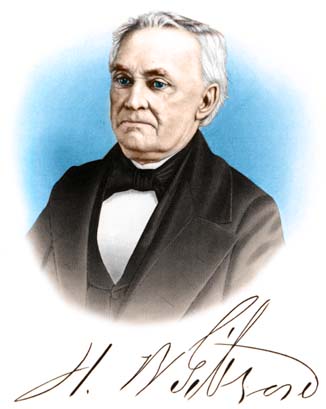
HENRY B. GIBSON
|
Growing Up
|
|
Henry Gibson, New York Dutch and Irish, was named for his mother's father, Colonel
Henry Bicker [Valley Forge Orderly Book], the Colonel being
the great grandson of Captain Martin Cregier, an early resident of New Amsterdam and
one of the first Burgo Masters of the town
[Journal].
John Gibson, Henry's father, was a lawyer of Irish extraction who had married Catharine Bicker
in Old Swede's Church in Philadelphia. It seems likely that John met the Colonel's daughter
while serving in the Revolutionary army. One year after the wedding, on April 13, 1783,
Henry Bicker Gibson was born in Reading PA. A year and a half later, Henry was joined by sister Mary.
At the age of nine, around 1790, Henry and his family moved to Sarasota NY, and that's where Henry received
his education. John intended his son to follow his own profession of law, but Henry found himself
more interested in mathematics. Unable to convince his parents of his preference for the commercial
world, the sixteen year old boy ran away to Cooperstown,
60 miles west of Albany,
where he became a clerk in the store
of Judge Cooper, the father of James Fenimore Cooper, and the leading merchant in town.
Seeking advancement, Henry removed to Utica around 1808 and, after a short stint with a merchant,
Hugh Cunningham, took a position with Francis A. Bloodgood, the county clerk, later a New York State senator.
In 1812, the young man accepted the post of teller in the Bank of Utica. Clashing with Washington Hunt,
the Cashier of the bank, Henry quit and instead went into partnership with his bride's father, Watts Sherman,
a leading Utica merchant who was also active in glass manufacturing in the area. Alexander Seymour, also
a partner, held down the Utica end of the business while Henry Gibson and Watts Sherman moved to New York
City to develop the wholesale end of the enterprise.
[Alexander Seymour was the grandnephew of Rev. Dirck Cornelius Lansing, a wealthy Presbyterian minister of the Auburn
and Syracuse area. Alexander's son Charles was later involved in Henry Gibson's railroads.]
By the time Henry had moved to Utica, his parents had moved from Sarasota to Ballston Spa, a popular
resort community close to Albany. On the first of March, 1807, Henry's sister Mary had married
Samuel Young, a
justice of the peace and town supervisor, who was soon to start his statewide political career.
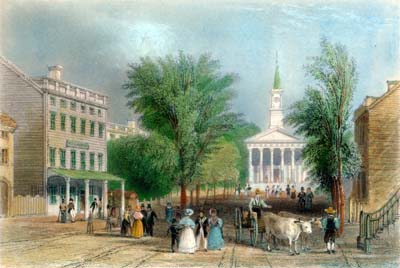
New York City proved to be a good move for Henry and Watts. The business made a fortune
for each of them. But in May of 1818, John Gibson died while serving his
first term in the New York Assembly, probably encouraged by Colonel Samuel Young, who had risen to Speaker of
the New York Assembly. In December of that same year, Watts Sherman also died.
Henry and Sarah were ready for a change.
|
|
Canandaigua
|
|
By 1819, Henry Gibson was worth about $30,000, a goodly sum for that time. His reputation for
financial acuity and honesty led to an offer being made to him to move to the relatively
young town of Canandaigua in western New York, and take over as Cashier of the Ontario Bank, an establishment
which had run into financial problems since it had been established in 1813.
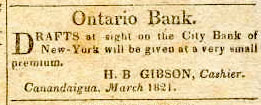
Following the birth of their 4th child, and 3rd daughter, Catharine Olivia Gibson, the family moved
from New York City to Canandaigua, and Henry threw himself into the life of the village.
In 1824, Henry was elected Village President. His portrait is still to be found in a courtroom of the
Canandaigua Courthouse.
Early Village Presidents
| 1815 | Nathaniel W. Howell |
| 1816 | Eliphalet Taylor |
| 1817-18 | Jermiah F. Jenkins |
| 1819-20 | James D. Bemis |
| 1821 | William H. Adams |
| 1822-23 | Francis Granger |
| 1824 | Henry B. Gibson |
|
While President of Canandaigua, Mark H. Sibley was
Village Clerk. Sibley was a noted lawyer, and later a
New York legislator and judge. Many years later, Sibley's son John would marry Henry's daughter Mary.
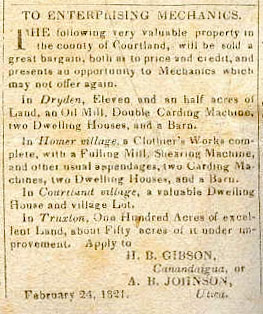
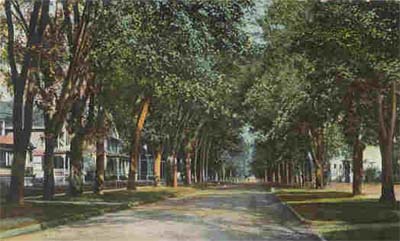
Immediately upon moving to the area, Gibson began to buy up large amounts of property, including
the Abner Barlow farm on which he laid out Gibson Street. This street intersects Main Street very close
to the Ontario Bank building.
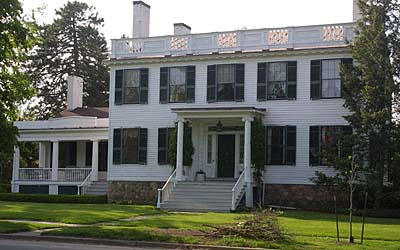
In later years, the Gibsons helped their daughter Catharine and her
husband, Henry Livingston Lansing
.
[more], purchase a house a
few blocks away from theirs, down Gibson Street. This house still exists, and is #NY-212 on the Historic American Buildings Survey.
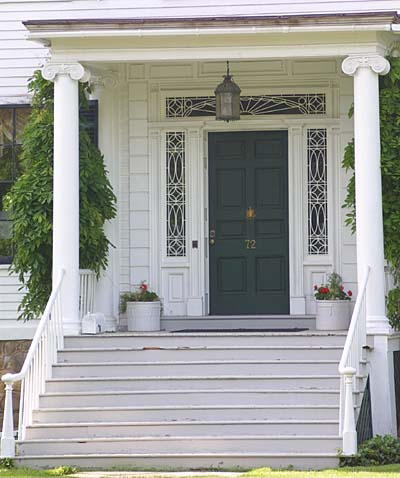
In 1823, Henry was a signatory on an Agreement of Moscow with the Senecas for a purchase of
Seneca land for $4286. Henry also purchased extensive property in the town of Manchester, in the only location where
Ontario County touched the Erie Canal.
Recognizing his obligations to his community, Gibson often donated land to good causes, including,
in 1825, the land for the Canandaigua Female Academy, an institution of learning for women.
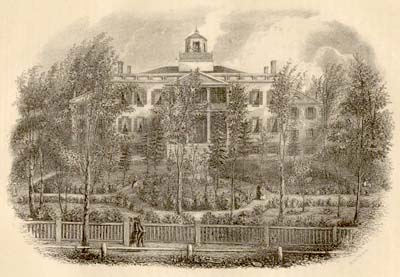
New England History, 2 Gen. Register, p. 282, Village of Canandaigua
Another Canandaigua school that gained national reputation, and that was in fact a pioneer in the movement for higher education for women, was the Ontario Female Seminary. This institution was incorporated in 1824, and in 1825 the building was erected on land deeded by Henry B. Gibson
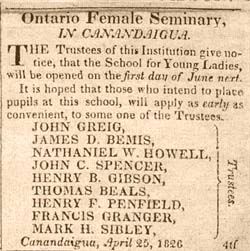
|
Whereas John Greig, Esq.,
has given the vestry the dwelling-house lately occupied by him, which is worth eight hundred
dollars, and Henry B. Gibson, Esq. has also presented a lot worth six hundred dollars, on which to
place said house, conveyance of which has been executed and recorded, Resolved unanimously, That
the thanks of this vestry, in behalf of themselves and the congregation of St. John's church, be
returned to those donors for their liberality, and a record of the act be placed on the minutes of the
vestry."
|
|
1834, St. John's Episcopal Church
When the Civil War came, reward monies were often used to encourage enlistment. The 126th Regiment was
recruited from Ontario, Yates, and Seneca counties, and Company D won a $200 reward from Henry Gibson as
the first company of the Regiment to form. Henry also contributed $500 toward subscriptions solicited
from the town by Noah T. Clarke, the principal of the Canandaigua Academy.
The History of Ontario County shows how the homes of some of the Village families were laid out.
|
Beginning of the public square and going up Main Street on the east side there were the following families:
Nathaniel Gorham, Mark H. Sibley, H.K. Sanger, Mr. Shepherd, Albert Daniels, Nathan Barlow, Dr. Dungan, Judge Howell, Wm. Judevine, Jared Willson, Henry Howe, Colonel Bunnell, John A. Stearns, Dudley Marvin.
Returning on the west side, there was the old tavern (Northern Retreat), Dr. Jacobs, Phineas P. Bates,
Elijah Forbes, Alex Duncan, John Greig, John C. Spencer, Spencer Chapin, John A. Granger,
Thomas Beals, Henry F. Penfield, Walter Hubbell, Ebenezer Hale, Nath. Sanborn, Mr. Brayton, Dr. Cheney,
H.B. Gibson, L. Jenkins and Judge Moses Atwater.
|
|
After he allowed the Ontario Bank charter to expire in 1856, Henry moved his family into the
elegant bank building, just south of the Congregational church. At that time, he had grown his fortune
to an estimated one million dollars, and was one of the richest men in western New York.
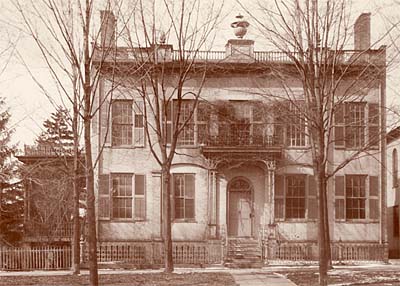
New England History, 2 Gen. Register, p. 275
Other mansions of historical associations once stood along this Main street,
but have been demolished to make room for structures of more modern, not more
beautiful, proportions. Among the most notable of these were the Thomas Morris house,
located at what is now the entrance of West Gibson Street;
the John Greig place, which stood opposite the Academy on upper Main street, and
the Gibson house, next south of the Congregational church,
where the Ontario bank was long located.
|
|
Businesses
|
|
ONTARIO BANK
History of Ontario County, New York, p. 240
In 1813, the old Ontario Bank was chartered by an act of the Legislature, and in the personnel of its management were the
leading men of the county seat. Nathaniel Gorham was its president, and William Kibbe was cashier.
The latter, however, was succeeded in 1821 by Henry B. Gibson, who was decidedly prominent in local history for many years. He continued with the bank until the expiration of its charter, in 1856, and afterward did a loaning business, but was not a banker later than that date. The Ontario Bank had a capital of $500,000.
The Ontario Bank was allowed to establish a branch bank at Utica, which was done April 10, 1815. However, by some process the branch was operated as a banking institution of Canandaigua, and was so continued for many years, under the direction of William B. Welles and H.K. Sanger.
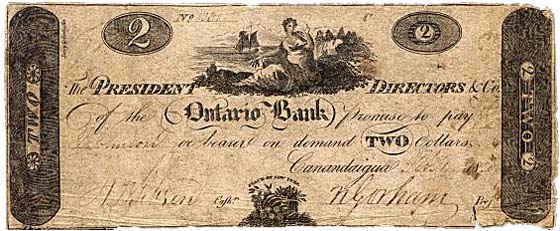
Counterfeit Bill
New England History, 2 Gen. Register, p. 304
The Ontario Bank established in 1813, the Utica Branch Bank established in 1815,
and the Ontario Savings Bank established in 1830, were the early banking institutions of the village, and
under the management of Henry B. Gibson and Thomas Beals,
men of unusual financial ability, and public spirited and influential citizens as well,
gave the business of the community a stability that with the single exception of the
distress resulting from the failure of the J.J. Messenger bank in May, 1868, has not
been disturbed. The financial interests of the community are now in the hands of two
substantial institutions, The Canandaigua National Bank and the Ontario National Bank,
which together have a capitalization of $200,000, a surplus of $165,000, and individual
deposits aggregating a million and a half dollars.
ONTARIO CANAL COMPANY
Besides taking over the Ontario Bank in 1821, and engaging in real estate speculation, Henry became
an active participant in other business ventures, including a canal company.
With the entire state excited over the building of the Erie Canal, the Canandaigua residents were
concerned that they weren't directly on the route. Their closest canal port in the county of Ontario
was in the northeast corner of the town of Manchester.
On March 31, 1821,
the New York legislature passed an act creating the Ontario Canal Company, with a proposed capitalization
of $100,000. The intention was to connect Canandaigua with Lake Ontario by building a canal over
a distance of 19 1/2 miles. John C.
Spencer, James D. Bemis, Asa Stanley, Dudley Marvin, and William H.
Adams proposed a canal requiring 23 locks at a cost of $68,000. The subscription list
was started May 23rd by the canal's commissioners -- N. Gorham, Z. Seymour, Asa Stanley, P. P. Bates, and William H. Adams -- but it wasn't until January 20, 1824 that enough capital had been raised,
$50,000, that a Board of Directors could be elected. The result of the meeting at Mead's hotel was a Board consisting of
Evan Johns, H.B. Gibson, Israel Chapin, Asa Stanley, J.C.
Spencer, Mark H. Sibley, Robert Pomeroy, and H.M. Mead.
OTHER BUSINESS VENTURES
Besides the bank, the canal company, railroads and land speculation, Henry Gibson was involved with
a number of business opportunities, including fire insurance and the construction of the Canandaigua
Hotel.
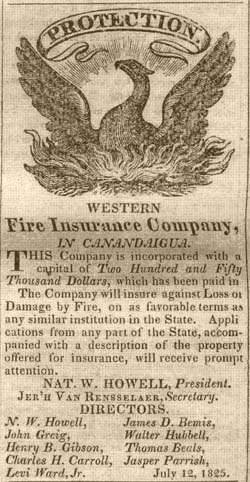
New England History, 2 Gen. Register, p. 278
The first big hotel of the village was the Blossom House, which was built in 1814, east of the
square, on the site of the present Canandaigua hotel. This was the favorite stopping place for the
Concord coaches that furnished communication to and from the settlements at the east and those
also to the westward. This hotel was destroyed by fire on the night of December 2, 1851.
Early the next year a stock company, consisting of John Greig, Francis Granger, Henry B. Gibson,
John A Granger, Mark H. Sibley, Leander H. Drury, and Gideon Granger, provided means, in
conjunction with Thomas Beals and John Benham, the owners of the land, for the building of a new
hotel. This was completed and opened in the summer of 1853 and constitutes the Canandaigua
Hotel of the present day.
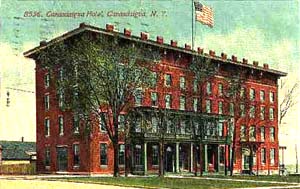
|
|
Agreement of Moscow NY with the Senecas, 3 Sep 1823
|
|
Unratified. Indian Office Compilation of Treaties, 1837, p. 305.
At a treaty held under the authority of the United States at Moscow, in the county of Livingston, in the State of New York, between the sachems, chiefs, and
warriors of the Seneka nation of Indians in behalf of said nation, and John Greig and Henry B. Gibson of Canandaigua in the county of Ontario, in the
presence of Charles Carroll, esquire, commissioner appointed by the United States for holding said treaty, and of Nathaniel Gorham, esquire, superintendent,
in behalf of the State of Massachusetts.
Know all men by these presents, that the said sachems, chiefs, and warriors, for and in consideration of the sum of four thousand two hundred and eighty-six
dollars, lawful money of the United States, to them in hand paid by the said John Greig and Henry B. Gibson, at or immediately before the ensealing and
delivery of these presents, the receipt whereof is hereby acknowledged, have granted, bargained, sold, aliened, released, quit claimed and confirmed unto the
said John Greig and Henry B. Gibson, and by these presents do grant, bargain, sell, alien, release, quit claim, and confirm, unto the said John Greig and
Henry B. Gibson,, their heirs and assigns, forever, all that tract, piece or parcel of land commonly called and known by the name of the Gordeau reservation,
situate, lying and being in the counties of Livingston and Genesee, in the State of New York, bounded as follows, that is to say:
Beginning at the mouth of Steep Hill creek, thence due east, until it strikes the Old Path, thence south until a due west line will intersect with certain steep
rocks on the west side of Genesee river, thence extending due west, due north, and due east, until it strikes the first mentioned bound, enclosing as much land
on the west side as on the east side of the river, and containing according to the survey and measurement made of the same by Augustus Porter, surveyor,
seventeen thousand nine hundred and twenty-seven 137-160 acres, be the same more or less:
Excepting nevertheless, and always reserving out of this grant and conveyance, twelve hundred and eighty acres of land, bounded as follows, that is to say; on
the east by Genesee river, on the south by a line running due west from the centre of the Big Slide so called, on the north by a line parallel to the south line and
two miles distant therefrom, and on the west by a line running due north and south, and at such a distance from the river as to include the said quantity of
twelve hundred and eighty acres and no more; which said twelve hundred and eighty acres are fully and clearly understood, to remain the property of the said
parties of the first part, and their nation, in as full and ample a manner, as if these presents had not been executed: together with all and singular the rights,
privileges, hereditaments, and appurtenances, to the said hereby granted premises belonging or in anywise appertaining, and all the estate, right, title, and
interest, whatsoever, of them the said parties of the first part, and of their nation, of, in, and to, the said tract of land above described, except as is above
excepted. [This excepted land was later conveyed in a separate Buffalo Creek Treaty of 1826.]
To have and to hold all and singular the above granted premises with the appurtenances, unto the said John Greig and Henry B. Gibson, their heirs and
assigns, to the sole and only proper use, benefit, and behoof, of the said John Greig and Henry B. Gibson, their heirs and assigns forever.
In testimony whereof, the parties to these presents have hereunto, and to three other instruments of the same tenor and date, one to remain with the United
States, one to remain with the State of Massachusetts, one to remain with the Senaka nation of Indians, and one to remain with the said John Greig and Henry
B. Gibson, interchangeably set their hands and seals, the third day of September, in the year of our Lord one thousand eight hundred and twenty three.
Saquiungarluchta, or Young King, his x mark.
Karlundawana, or Pollard, his x mark.
Sagouata, or Red Jacket, his x mark.
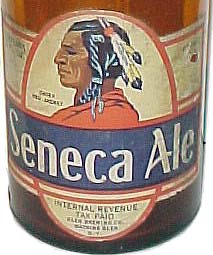 Tishkaaga, or Little Billy, his x mark.
Tishkaaga, or Little Billy, his x mark.
Tywaneash, or Black Snake, his x mark.
Kahalsta, or Strong, his x mark.
Chequinduchque, or Little Beard, his x mark.
Tuyongo, or Seneka White, his x mark.
Onondaki, or Destroy Town, his x mark.
Lunuchshewa, or War Chief, his x mark.
Genuchsckada, or Stevenson, his x mark.
Mary Jamieson, her x mark.
Talwinaha, or Little Johnson, his x mark.
Atachsagu, or John Big Tree, his x mark.
Teskaiy, or John Pierce, his x mark.
Teaslaegee, or Charles Cornplanter, his x mark.
Teoneukaweh, or Bob Stevens, his x mark.
Checanadughtwo, or Little Beard, His x mark.
Canada, his x mark.
Sealed and delivered in the presence of
Nat. W. Howell
Ch. Carroll
Jasper Parfish
Horatio Jones
Done at a treaty held with the sachems, chiefs, and warriors of the Seneka nation of Indians at Moscow, in the county of Livingston and State of New York,
on the third day of September, one thousand eight hundred and twenty-three, under the authority of the United States.
In testimony whereof, I have hereunto set my hand and seal, the day and year aforesaid, by virtue of a commission issued under the seal of the commonwealth
of Massachusetts, bearing date the 31st day of August, A. D. 1815, pursuant to a resolution of the legislature of the said commonwealth, passed the eleventh
day of March, one thousand seven hundred and ninety-one.
N. Gorham, Superintendent.
I have attended a treaty of the Seneka nation of Indians held at Moscow in the county of Livingston and State of New York, on
the third day of September, in the year of our Lord one thousand eight hundred and twenty-three,
when the within instrument was duly executed in my presence, by the sachems, chiefs, and warriors of the said nation, being fairly and properly understood
and transacted by all the parties of Indians concerned, and declared to be done to their full satisfaction. I do therefore certify and approve the same.
Ch. Carroll, Commissioner.
Indian Affairs. Laws and Treaties. Vol. II. (Treaties.) Compiled and Edited by Charles J. Kappler, LL. M., Clerk to the Senate Committee on Indian
Affairs. Washington: Government Printing Office. 1904.
A Narrative of the Life of Mary Jemison: white woman of the Genesee,
pp137-139
In the month of August, 1817, Mr. Brooks and Esq. Clute again came to me with a request that I would give them
a lease of the land which I had already deeded to them, together with the other part of my reservation,
excepting and reserving to myself only about 4000 acres.
At this time I informed Thomas Clute of what John had advised, and recommended me to do, and that I had consulted
my daughters on the subject, who had approved of the measure. He readily agreed to assist me: whereupon I told him
he was entitled to a lot of land, and might select as John had mentioned. He acordingly at that time
took such a piece as he chose, and the same has ever since been reserved for him in all the land contracts
which I have made.
On the 24th of August, 1817, I leased to Micah Brooks and Jellis Clute, the whole of my original
reservation, except 4000 acres, and Thomas Clute's lot. Finding their title still incomplete, on
account of the United States government and Seneca Chiefs not having sanctioned my acts, they solicited me
to renew the contract, and have the conveyance made to them in such a manner as that they should
thereby be constituted sole proprietors of the soil.
In the winter of 1822-3, I agreed with them, that if they would get the chiefs of our nation, and a
United States Commissioner of Indian Lands, to meet in council at Moscow, Livingston county, N.Y. and there
concur in my agreement, that I would sell to them all my right and title to the Gardow reservation,
with the exception of a tract for my own benefit, two miles long, and one mile wide, lying on the river
where I should choose it; and also reserving Thomas Clute's lot. This arrangement was agreed upon, and the
council assembled at the place appointed, on the 3d or 4th day of September, 1823.
That council consisted of Major Carrol, who had been appointed by the President to dispose of my lands,
Judge Howell and N. Gorham, of Canandaigua, (who acted in concert with Maj. Carrol,) Jasper Parrish,
Indian Agent, Horatio Jones, Interpreter, and a great number of Chiefs.
The bargain was assented to unanimously, and a deed given to H.B. Gibson, Micah Brooks
and Jellis Clute, of the whole Gardow tract, excepting the last mentioned rservations, which was signed by
myself and upwards of twenty Chiefs.
The land which I now own, is bounded as follows: - Beginning at the center of the Great Slide and running west
one mile, thence north two miles, thence east about one mile to Genesee river, thence south on the west
bank of Genesee river to the place of beginning.
In consideration of the above sale, the purchasers have bound themselves, their heirs, assigns, &c. to pay
to me, my heirs or successors, three hundred dollars a year forever.
Whenever the land which I have reserved, shall be sold, the income of it is to be equally divided among
the members of the Seneca nation, without any reference to tribes or families.
|
|
Railroads
|
|
Auburn and Rochester Railroad
xx
[Extended Description]
The Auburn and Rochester, which was chartered on 13 May 1836, was one of the
longest (70 miles) of the railroads that eventually became the New York Central. As
was the case with the Auburn and Syracuse, the line was intended to serve cities
that had not benefited from the Erie Canal. Since these lines were not in direct
competition with the canal, they were not subject to the same operational restrictions
imposby the legislature on lines that parallel the canal. The Auburn and Rochester,
completed in 1841, ran from Auburn through Seneca Falls, Waterloo, Geneva,
Manchester and Canandaigua to Rochester.
Picture of 'Young Lion' Engine
From 'Rochester's Transportation Heritage', NY By Donovan A Shilling
10 Sep 1840 - 'Young Lion' inaugurates Auburn & Rochester
12 Sep 1840 - The first train on the Auburn & Rochester Railroad arrives in Canandaigua
Rochester History, Vol XXX October, 1968, No 4,
Railroads in Rochester's History
by Blake McKelvey, pp.4-8
xx
[Extended PDF Description]
...
Even before the opening of the Tonawanda line a second steam railroad, the Auburn & Rochester, was under construction. Organized in the early thirties and finally chartered in April 1836, it was designed to link the old Ontario County towns of Canandaigua and Geneva to the rising city of Rochester. Most of the cbacking for this new line came from these towns as their leaders sought to recoup the prestige lost when the canal bypassed them to the north. The directors chose Henry B. Gibson of Canandaigua as president and James Seymour, formerly of that town but then a banker in Rochester, as vice-president. Despite delays occasioned by the onset of the depression, construction progressed in the late thirties and reached Canandaigua in September 1840, Geneva by the next July, Seneca Falls in August, Waterloo in September, and entered Auburn 78 miles to the east on November 4, 1841.
The first engine, again brought by canal boat from the east and named "The Young Lion" (after Rochester's original canal packet now long since retired), steamed from Rochester to Canandaigua on September 10, 1840. The three daily trains operated the next year gradually extended their runs eastward to Auburn thus completing the last link in a loose chain of independent railroads stretching eastward to Albany and westward to Buffalo.
...
The opening of rail connections to Albany in 1842 enabled the Auburn & Rochester to bring in six elegant new coaches each fitted to seat 50 passengers and priced at $1.700. Laudatory descriptions of these coaches, each equipped with separate lavatories for men and women, prompted the other roads to improve their accomodations. Sturdier engines were soon required, and the additional weight quickly revealed the inadequacy of the track. The original strip rails (which occasionally broke loose when friction from a heavy engine heated the top side, contracting it sufficiently to cause it to spring loose from its spikes and to curl up, snagging or derailing the cars) had to be replaced by heavier rails. Both the Tonawanda and the Auburn & Rochester replaced their strip iron rails in 1848 with the new T-bar rails laid on frequent cross ties and won praise from Hunt's Merchants Magazine for the superior quality of their road beds. Despite interruptions for these improvements both roads enjoyed increased patronage, carrying 148,500 and 299,300 passengers respectively that year and recording profits of $57,000 and $96,000 from their freight shipments, sufficient with the larger passenger revnue to pay 8 per cent dividends to their stockholders.
The History of the New York Central System, p.18
Canandaigua, however, was brought into direct and rapid communication with the rest of the country
by the building of the Auburn and Rochester railroad, an enterprise in which two of its leading
citizens, Francis Granger and Oliver Phelps, 3d, took an active part, and upon the organization
of which Henry B. Gibson, of Canandaigua, became its president.
After varied incidents and accidents the road was completed between Canandaigua and Rochester,
and on Saturday, September 12, 1840, a locomotive and three cards came through to Canandaigua
and made the return trip the Monday following. Within a few days a rude station house was
built west of Mr. Gibson's residence, near where Greig terrace now intersects the Auburn
branch, and there was opened, as the first time table advertised, "for freight and passage three daily lines."
History of Ontario County, New York, page 57
The Auburn and Rochester Railroad was authorized by legislative act passed May 13, 1836. The
people along the proposed route regarded it as a doubtful experiment, and were not easily convinced
that it would be beneficial to the towns through which it passed, or a good investment to stockholders.
The capital stock was $2 million, which was in shares of $100, and each share was to be deemed personal
property. ... and the company were allowed to connect with the Auburn and Syracuse road, at Auburn.
The first officers of the road were Henry B. Gibson, president, and Charles Seymour, secretary and treasurer. The first train ran September 12th evening with three cars and left for Rochester the morning after next. On September 22 the time-table was issued; there were for freight and passengers three daily lines." A rude depot was built west of H.B. Gibson's residence at Canandaigua.
History of the canal system of the state of New York, Noble E. Whitford, 1906
[David Stanhope] Bates was called to be chief engineer of the Ohio canal
system, of the Louisville and Portland canal, and the Erie and Kalamazoo railroad, and served also
with the Auburn and Rochester railroad and the Niagara River Hydraulic Company. Jervis
became chief engineer of the Delaware and Hudson canal, the Croton Aqueduct, the Albany and
Schenectady and the Hudson River railroads.
Rochester and Syracuse Railroad
xx
[Extended Description]
The History of the New York Central System, p.18
Another "straightening" was accomplished by the 1850 merger of the Auburn and Syracuse
and the Auburn and Rochester into a line called the Rochester and Syracuse Railroad
Company. The new line replaced a serpentine, single-track line with a direct double-track
system between these two important cities. The old line was kept in use for local traffic. The
double-track line, which was finished only a month before the formation of the New York
Central, became one of its busiest sections.
Bates was called to be chief engineer of the Auburn and Rochester
railroad.
New York Central Railroad
xx
[Extended Description]
New England History, 2 Gen. Register, p. 278
The Direct Railway between Syracuse and Rochester, incorporated June 18, 1848, was
merged with the Rochester and Syracuse Railroad Company under date of August 6, 1850.
Consolidated into the New York Central Railroad Company under the act of 1853.
The New York Central was founded in 1853, it was made of 10 small railroads that paralleled
the Erie Canal between Albany and Buffalo. The New York Central's moving spirit was
Erastus Corning (1794-1872), four times mayor of Albany, who for 20 years had been
president of the Utica and Schenectady, one of the consolidated roads.
The Road of the Century, p.52
Another effort at coordination is found in a letter from Henry B. Gibson, president of the Auburn & Rochester,
to President Corning of the Utica & Schenectady, dated May 31, 1842, in which he makes two proposals
"to produce uniformity of arrangement and fare upon the Rail Road west of Albany." These were:
First: That passengers be allowed at the principal office on the line to pay their fare as far as they please.
Second: That they be allowed to put their baggage in for such place as they please, and that they be furnished with a metal
ticket therefor, a duplicate of which will be attached to the baggage.
(Baggage checks had begun to be manufacturered
in Massachusetts).
A third suggestion was for a second-class train, "a daily line of cars of a plain but substantial
character," slower and cheaper than the better ones, to run from Albany to Rochester and eventually
to Buffalo. Such a train, painted a dark, somber color, and popularly known as the Hyena Train, did run
for a while, but the officials were so shocked to discover that so many well-to-do folk, who could afford better
accomodations if they chose, were riding on it, that it was discontinued, even though a through arrangement
for it had been made with the other railroads. The through agreement between Albany and Rochester,
consummated on July 22, 1842, allowed the Auburn & Rochester, consummated on July 22, 1842, allowed
the Auburn & Rochester $3 for its 78 miles in a first-class carriage and only 87 1/2 cents for the second class.
This may have had much to do with the elimination of the Hyena Train and the raising of the second-class fare to $1.50.
That long bridge across the Cayuga shallows was a startling experience to those who crossed it for the first
time. Mrs. M.C.J.F. Houstoun, an English tourist, thus writes of it:
The railroad crosses the lake, and that, too, in a manner which it would be death to a nervous person
even to dream of. For a distance of more than two miles, the rails are laid on wooden posts, which are driven into the earth
at the bottom of the lake. There is but just room for one line of rails, and no fence whatever on either side. A dreary waste of waters is seen from the windows, and over this highly unsatisfactory
bridge one is hurried at full speed. Frequent were the exclamations of alarm which broke fronm the
ladies, particularly from those who now for the first time trusted themselves to the insecure fabric, and felt
the peculiar shaking movement and heard the hollow sound caused by the echoing of this novel style of bridge."
Within a year after its opening, the new road was bickering with its neighbor and connection, the Auburn & Syracuse.
The latter evidently did not consider the Auburn & Rochester a good risk, for its freight agent at
Auburn was ordered to deliver no freight to the A. & R. until the A. & S. charges on it had been paid.
This brought on some acrimonious exchanges, and finally, in December, 1832, a letter from the A. & R.
secretary-treasurer to Mr. How (whose nerves may have been a little overwrought by his long financial strain),
which read in part as follows:
Our President, Mr. Gibson, says he is about as sick of co-partnership as you would seem to be by the unceremonious manner
in which you discontinued our recent connection for running our cars to Syracuse. He adds that if you had
called and stated the difficulties or objections you had to continuing the arrangement, they would in all
probability have been obviated by us, but as it is, we will hereafter do business on our own hook, and leave
you to the enjoyment of the same course, or any other you may deem expedient to adopt.
|
|
Recognition
|
|
Besides Gibson Street, which Henry named for himself, his name survives only in
Port Gibson NY, the community that was hoped to be the connection point between
Canandaigua and the Erie Canal.
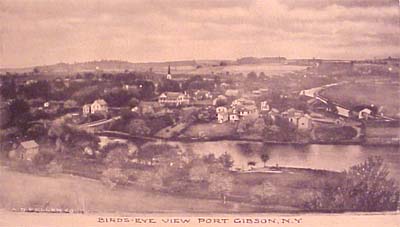
After Henry's death the "Henry B. Gibson", a Canandaigua Lake Steamer
launched in 1860, was sold to the Warner Brothers and renamed "The Naples." She was
destroyed in the ice at Canandaigua in December of 1865.
|
|
Henry B. Gibson (13 Apr 1783 - 20 Nov 1863)
|
|
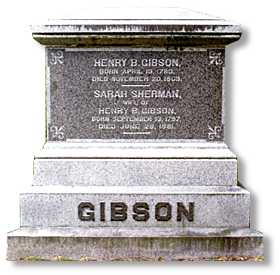
|
Ballston Journal, December 1, 1863
|
|
At Canandaigua, on the 20th inst., Henry B. Gibson, Esq, aged 80 years.
Mr. Gibson was a native of the town of Ballston, in this County, and brother-in-law of the late Col Samuel Young, of that town. Beginning life as a merchant's clerk, and becoming, subsequently, Cashier of the Ontario Bank, at Canandaigua, the deceased, by a long life of close application to business, and the most scrupulous integrity, died one of the wealthiest men in Western New York. His dies deeply regreted by all who ever knew him.
|
|
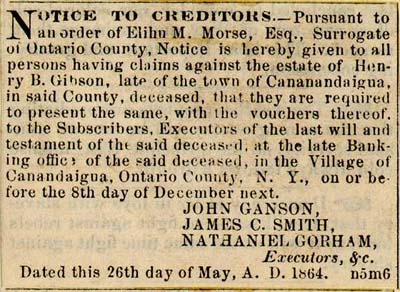
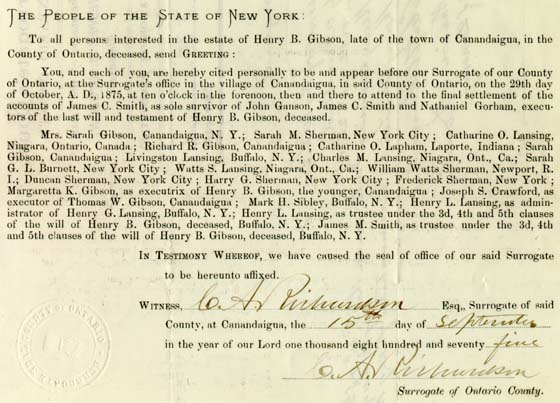
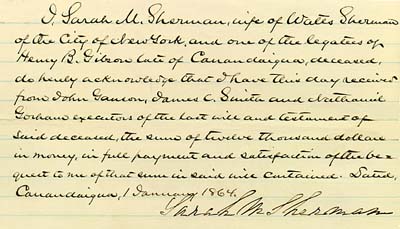
Sarah Maria Gibson, wife of Watts Sherman
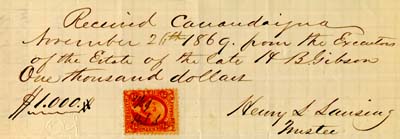
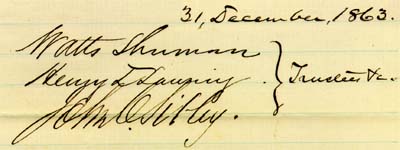
Watts Sherman
Henry L. Lansing
John C. Sibley
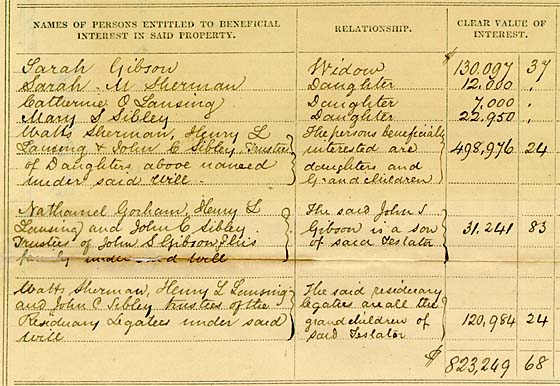
|
SURROGATES COURT - ONTARIO COUNTY
|
|
In the Matter of the Estate
of
HENRY B. GIBSON
STATEMENT OF FACTS
Henry B. Gibson died in 1863. By the third clause of his will he gave to his trustees
securities amounting to one hundred and fifty thousand dollars, in trust to pay the
income to his daughter, Mrs. Catherine O. Lansing, for her use during her life, and providing
that if at her death she should leave less than four children surviving her, each of them should
have thirty seven thousand five hundred dollars of said fund, and the residue should go to the
grandchildren of the testator then living, in equal shares.
Mrs. Lansing died October 25, 1897, leaving two children surviving her, and there were then
living several grandchildren of said Henry B. Gibson, including the two children of
Mrs. Lansing.
The question which presents itself is whether the trust fund is now subject to the transfer
tax under Chapter 008 of the laws of 1896, as amended.
|
|
|
|
Sarah Sherman (15 Sep 1796 - 28 Jun 1881)
|
|
Hearing for son to object to mother's Will Codicil
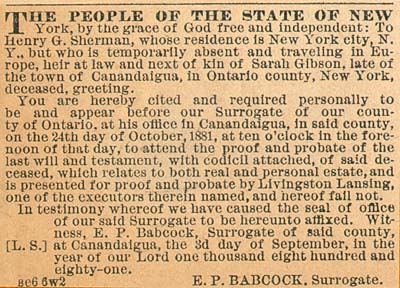
|
|
|




 Copyright © 2003, Mary S. Van Deusen
Copyright © 2003, Mary S. Van Deusen